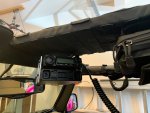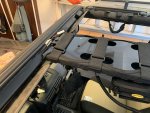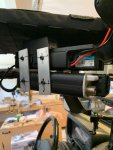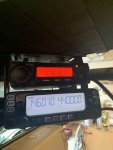I was thinking if I can get a suitable 40 amp relay why not go ahead and wire it for 40 amps... I wasn't sure which relay to get looking either at the list that comes up via the Amazon link below
or possibly one of the 3 Bosch relays that comes up when you filter for 40 amps (0332019157, 0986332030 and 0986332040):
My concern is that some of those 40 amp relays look a whole lot like the 30 amp relays, and I'm not sure I'd trust some of the cheap Chinese sourced ones. Bosch is a reputable company, so if they have a 40 amp relay that meets all your specs, that's probably the way to go.
Those two radios probably draw more like 10 amps or so each, maybe a bit more, so unless you were transmitting with both at the same time, unlikely you'd have any issues with a 30 amp circuit. You'd still have some headroom to spare for future accessories. If you can do 40 amps, then go for it. If you can only do 30, I think you'll be fine.
If that doesn't work then I was going to get the Blue Sea 30 amp Maxi fuse for the in-line fuse holder near the battery:
And then would this 30 amp Bosch relay the right one?
Should be fine. Make sure you get one that's rated for continuous duty. These sorts of relays almost always are, but some larger starter solenoid type relays are only rated for intermittent duty.
I ordered the one I originally linked to. For whatever reason, I like the idea of the fuse block having the negative terminals as well.
Makes the wiring neater. I have a fuse block in my personal truck that doesn't have a ground buss, but I bought a separate one to use. I have them mounted side by side.
Consider mounting them on a piece of exterior grade plywood. I used a piece, spray painted it black, and bolted it down behind the rear seat in my truck. That makes for an easy place to mount everything and secure wiring. You can figure out what size you need, then assemble everything on your bench where you can easily get to it, then mount the completed product under the seat.
On that note, make sure you use high quality crimp terminals and a proper set of full cycle ratcheting crimpers. They'll do a good crimp every time. You can also slide some suitably sized heat shrink over them to protect everything. I can imagine that even under the seat of a Jeep can occasionally see some water/mud, so protecting everything you can is a good idea. Marine grade heat shrink works really well. It has a hot melt adhesive inside that flows when heated up and sort of glues everything together. Works as a great strain relief and helps keep water/corrosion out. 8 gauge is usually beyond the capability of most crimpers, so make sure you get good ones. Also, consider the copper crimp lugs rather than the tinned/insulated kinds. They do a nice job.
Label everything, even if you think you'll remember what it is later on. One option is to use P-Touch type labels and then slide a piece of clear heat shrink tubing over them. I do that on most of the wiring I do at work and in my own vehicle. Makes it easier to troubleshoot things down the road, and in my work case, makes it easier for someone to work on it if I'm not there.
Let's see if I understood correctly. I drew up (very crudely) how I understood everything below. The way I was thinking about it is pretty much exactly as you described just above. This is missing the wiring for the switch, more about that near the end of the thread.
Looks good.
Here is how the radios are mounted now. I am finishing up the brackets I made for the IC-2730A.
I could use these ground straps for the radios and run them either to the metal overhead console or maybe where the existing wires are hidden against the windshield under the molding or to the overhead console itself.
Buy 20" x 1/2" Braided Ground Straps (1/2" Ring to 1/4" Ring)-3pcs: Amplifier Installation - Amazon.com ✓ FREE DELIVERY possible on eligible purchases
www.amazon.com
That'll work, but it's kind of expensive. The braid is nice since it's really flexible. You can make your own with the outer shield from coaxial cable and some crimp on connectors. Even regular 14 gauge wire will work just fine.
Both radios indeed have a 15 amp inline fuse on both the positive and negative leads. Got it, so I can drop the in-line fuses once wired to the fuse block or does it not hurt to leave them in place?
Fuse connection usually have a bit of resistance to them, so there can be a voltage drop across them. Also, it's one more place you have to check if you have an issue. You are protected by the fuse on the fuse block, so it's not necessary. I'd leave them out. Probably a different flavor fuse also, so more spares you'd have to carry.
Ok, I will be able to shorten the run for the power leads thankfully provided the under-the-passenger seat mounting for the fuse block works out. Right now the power leads are extended by the 14 gauge wire out to the battery. That should effectively remove about half the total length from radio to fuse block. It'll just have to run from the radios mounted overhead down the passenger side roll bar and to the fuse block under the seat.
That'll be good. Less small gauge wire means less voltage drop. It also will make your overall wiring look cleaner.
I'd also suggest getting some split loom tubing to cover up any wiring you run. It does a couple of things:
1. It adds a layer of protection to the wiring.
2. It hides it well. You can look at the work and personal vehicles I've done and usually you cannot see any of the added wiring in the engine bay. My goal is to have all wiring hidden and the few places it shows, it's covered in split loom.
If you are going to use it in the engine bay, make sure you get stuff that's rated for higher temperatures. If you route carefully, you probably won't need it, though.
I need to figure out where in the Jeep to get the ignition controlled power from. I was thinking about the head unit, but I already am using that lead for an aftermarket head unit/wiring harness.
That is always a challenge. Consumer oriented vehicles don't make it easy. 3/4 and 1 ton trucks, especially the newer ones, as well as the special police package vehicles usually have wiring set aside for this. My F350's all had it already there in the cab.
You can find existing wiring or dedicated terminals on some cars, but you may need to check with the owners manual, service manual or if there is an upfitters guide for your Jeep. Fuse taps are usually not a good option as they can vibrate loose. One thing you can do on some vehicles is find unused circuits. I had a couple of Chevy Colorados at work and found the sun roof wiring taped off in the A pillar. Since the trucks didn't have sun roof options, I was able to tap into the unused wiring and extend it to the ignition sense lead for the radios. I found the sun roof fuse slot (unused) and put in a 3 amp fuse and I was good to go.
Is a 5 amp fuse fine for the ignition controlled power also or should I look that up in the Jeep owner's manual or other technical info I have?
All it needs to do is drive the relay coil and an LED indicator lamp on the switch. 5 amps should be more than enough.
I was thinking of using these in-line fuse holders as well for the relay/switch wiring:
Buy Blue Sea Systems In-Line ATO/ATC Fuse Holder: Fuse Holders - Amazon.com ✓ FREE DELIVERY possible on eligible purchases
www.amazon.com
Yeah, that will work, but connecting it to the rest of the wiring is a pain. Generally I avoid using butt splice connectors whenever possible. They are a popular failure point and they can be difficult to crimp properly. One of these might look a bit cleaner and give you less issues in the long run:
Buy JooFn Waterproof Sealed ATO ATC Fuse Holder Assembly Splice Existing Wire Kit (Pack of 6): Fuse Holders - Amazon.com ✓ FREE DELIVERY possible on eligible purchases
www.amazon.com
Or this:
Thanks for the link to the Caltran doc as well - I will give that a good read!
Most of it overkill for hobby stuff, but if you really rely on your radios, there's a lot of good methods and info in that document.






